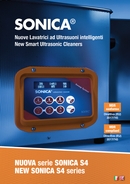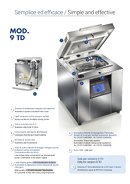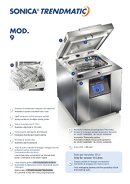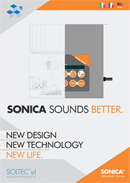Technical
What is SONICA sweep system technology?
Submitted by soltec-admin on Mon, 05/03/2010 - 16:53
in
The new SONICA EP series is the best that you can ask from ultrasonic cleaning equipment.The state-of-the-art generator incorporates a special ultrasonic oscillator using Sweep System Technology. The frequency from the ultrasonic generator deviates around a central frequency of 40 Khz and the transducers shift between 39 and 41 Khz.
How many applications have ultrasounds?
Submitted by soltec-admin on Mon, 05/03/2010 - 16:52
in
There are a lot of applications. The main application of ultrasound during Worl Wars I and II was in the use of sonar. After that time there has been a proliferation of ultrasound applications in industry, medicine and on the consumer market. In industrial applications of high-power ultrasound we can find in cleaning, degrasing, soldering and brazing,plastic and metal welding, machining, extraction, atomization, emulsification, dispersion, homogenization, degassing, electroplating and more.
- 5003 reads
- Italiano
-

What is an ultrasonic sweep generator?
Submitted by soltec-admin on Mon, 05/03/2010 - 16:51
in
If a ultrasonic cleaners use a sweep generator, the frequency of the output is modulated around a central frequency. For example SONICA EP ultrasonic cleaners series use a special sweep generator that drives the transducers with a frequency between 39 and 41 Khz.This sweep operation reduce the effects of standing waves in the cleaning tank by improving the distribution of ultrasonic energy in the bath.
What is the correct ultrasonic tank size?
Submitted by soltec-admin on Mon, 05/03/2010 - 16:49
in
Tank size should be selected based on the largest workpieces that will be cleaned. Parts should not displace more than about 35% of the volume of cleaning solution.
What is resonant frequency in a ultrasonic transducer?
Submitted by soltec-admin on Mon, 05/03/2010 - 16:47
in
It's the frequency at which it operates most efficiently. The transducers are designed to match the frequency need of the application. A transducer is generally designed to oscillate around a principal or central frequency. In benchtop ultrasonic cleaners the ultrasonic frequency commonly used are 20 to 50 Khz.
Lower frequency systems produce more intense cavitation but higher frequency systems have less dead zones because the cavitation bubbles are smaller and their distribution are improved. Higher frequency is required to remove smaller particles.
Is surface tension important for cavitation?
Submitted by soltec-admin on Mon, 05/03/2010 - 16:31
in
Yes, for a ultrasonic detergent is important a low surface tension because cavitation bubble grows more easily. Also viscosity of the detergent should be low in order to promote cavitation. It's important ot remember that surface tension and viscosity of a liquid usually decrease with an increase in temperature.
How is possible to increase the vapour pressure of a liquid in a ultrasonic bath?
Submitted by soltec-admin on Mon, 05/03/2010 - 16:30
in
The vapour pressure increases with temperature. A moderate increase in temperature brings the liquid closer to its vapour pressure, making it easier to achieve vaporous cavitation. Water cavitates most effectively at about 50°-60°C and ceases at the boiling point.
When should I use the glass or plastic beakers during ultrasonic cleaning process?
Submitted by soltec-admin on Sat, 05/01/2010 - 12:13
in
Special beakers with an adjustable black rubber support ring are available on request. They are used to save detergent liquid whenever small quantities of objects are to be cleaned, or if washing is to be performed with a detergent solution in a beaker and rinsing simultaneously in another beaker. They are also used to wash objects with particularly aggressive solutions which must not come into direct contact with the steel tank. This kind of cleaning is also called "indirect cleaning" because the solution (generally aggressive for the tank) does not fill the ultrasonic tank.
When should solutions be changed?
Submitted by soltec-admin on Sat, 05/01/2010 - 12:02
in
Cleaning solutions should be changed when decreses the cleaning action or when the solution is dirty.
Where are attached the ultrasonic transducers?
Submitted by soltec-admin on Sat, 05/01/2010 - 12:00
in
Generally the transducers are attached to the ultrasonic tank bottom. The vibrating element trasmits a sonic wave into the liquid in the ultrasonic tank.








